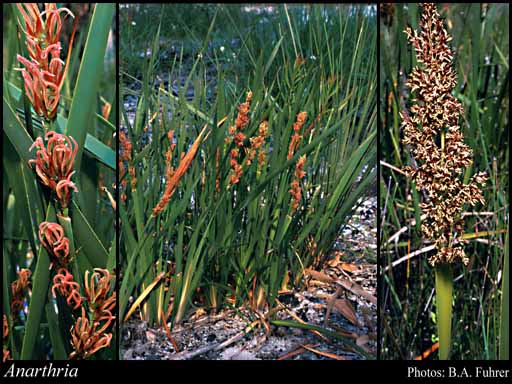- Reference
- Prodr.Fl.Nov.Holland. 248 (1810)
- Name Status
- Current

Scientific Description
Family Anarthriaceae.
Sometimes included in Restionaceae.
Habit and leaf form. Rushlike herbs (the stems simple or branched, sometimes very compressed); evergreen. Switch-plants; phyllodineous. Plants with roots. Perennial. Leaves basal, or cauline. Plants with neither basal nor terminal concentrations of leaves. Stem internodes solid (usually), or hollow. To 0.05–0.8 m high; rhizomatous. Helophytic. Leaves medium-sized, or large; alternate; ‘herbaceous’; imbricate, or not imbricate; sessile; sheathing. Leaf sheaths not tubular. Leaves edgewise to the stem (stemlike); simple. Leaf blades isobilateral, or centric; entire; flat, or solid; terete; not grooved; linear. Mature leaf blades glabrous. Leaf blade margins entire. Leaves with a persistent basal meristem, and basipetal development. Vegetative anatomy. Plants without silica bodies. Leaf anatomy. Guard-cells ‘grass type’ (grasslike). Hairs absent. Stem anatomy. Secondary thickening absent.
Reproductive type, pollination. Fertile flowers functionally male and functionally female (rarely), or functionally male, or functionally female. Unisexual flowers present. Plants dioecious. Female flowers aggregated in ‘inflorescences’; without staminodes. Male flowers solitary (or in small groups of up to 3), or aggregated in ‘inflorescences’; without pistillodes. Anemophilous.
Inflorescence and flower features. Flowers aggregated in ‘inflorescences’; in cymes, or in panicles; not in ‘spikelets’. Inflorescences terminal; lax paniculate cymes; spatheate (the spathe usually caducous). Flowers pedicellate, or subsessile; bracteate; bracteolate, or ebracteolate; small; regular; 3 merous; cyclic. Perigone tube absent. Perianth of ‘tepals’; 6; 2 -whorled; isomerous; free; sepaloid; similar in the two whorls (glumelike). Fertile stamens present (with no pistillode, in male flowers), or absent (in females). Androecium 3. Androecial members free of the perianth; all equal; free of one another, or coherent; when coherent, 1 - adelphous (the filaments connate); 1 -whorled. Androecium exclusively of fertile stamens. Stamens in male flowers, 3; becoming exserted; all more or less similar in shape; isomerous with the perianth; oppositiperianthial. Anthers basifixed; dehiscing via longitudinal slits; latrorse; tetrasporangiate. Fertile gynoecium present, or absent (in males). Gynoecium 3 carpelled. The pistil 3 celled. Carpels isomerous with the perianth. Gynoecium syncarpous; synstylovarious to eu-syncarpous; superior. Ovary plurilocular; 3 locular; sessile. Gynoecium stylate. Styles 3; free; simple; apical; becoming exserted. Stigmas 3. Placentation apical. Ovules 1 per locule; pendulous; orthotropous.
Fruit and seed features. Fruit 1.5–7 mm long; non-fleshy; indehiscent; a nut; 3 celled; 3 locular. Dispersal unit the seed. Fruit 1–3 seeded. Seeds 1 per locule. Seeds endospermic (the endosperm mealy); small.
Geography, cytology, number of species. World distribution: South West Australia. Native of Australia. Endemic to Australia. Australian states and territories: Western Australia. South-West Botanical Province. A genus of 7 species; 7 species in Western Australia; 7 endemic to Western Australia.
Additional characters Stigmas the stigmatic area linear. Stems glabrous; simple, or branched; not dimorphic. Caespitose, or not caespitose (rooting at stem nodes in A. prolifera; stilt-rooted in A. egrallata). Male flowers without a swollen base. Pericarp thin-textured. Stem internodes with 1 central cavity (or solid). Leaf sheaths more than 3.
Etymology. From the Greek for "without joints".